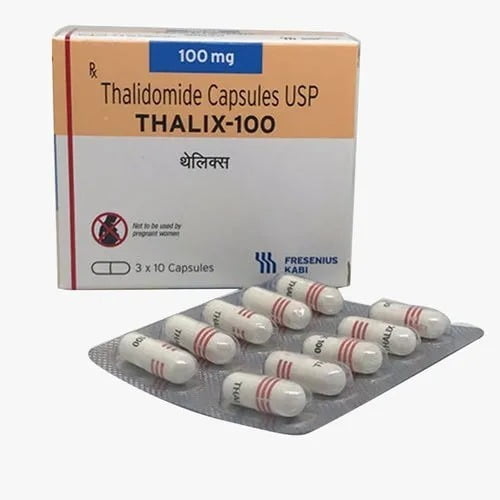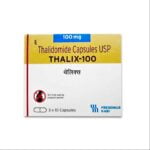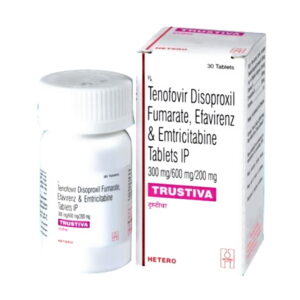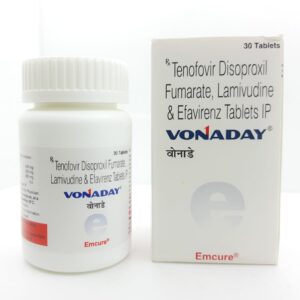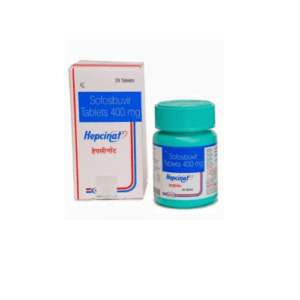Last Updated on September 8, 2024 by admin
Buy Thalix 100 HivHub
Thalix 100 INTRODUCTION:
THALIX 100 contains Thalidomide which belongs to the group of medicines called Immunomodulating Agents. It is used in combination with other medicines (melphalan and prednisone) for the treatment of a type of cancer called multiple myeloma in patients aged over 65 years and have not been prescribed with any other medicine and in patients above 65 years of age who cannot tolerate high doses of chemotherapy.
Multiple Myeloma is a certain type of cancer which affects a specific white blood cell called plasma cell. It is also indicated in treatment of skin symptoms associated with severe Erythema Nodosum Leprosum (ENL). ENL is a complication of leprosy which presents on the skin as tender bumps.
Before starting the treatment with THALIX 100, your doctor might want you to take some diagnostic tests to understand your existing condition.
Before taking THALIX 100, inform your doctor if you have or had liver, heart or kidney disease, diabetes, frequent infections, hepatitis B, numbness, pain and tingling in hands or feet, severe skin rash, seizures, thyroid problems, blood clots, high blood pressure or high cholesterol, healing wounds and had surgery in in the previous 7 days.
THALIX 100 is not recommended for use in pregnant and breast-feeding women. Consult with your doctor before taking it.
It should be used with caution in men as it passes through the semen. Men must not donate semen while getting treated with THALIX 100 and should use effective contraception. THALIX 100 should not be taken by children under 12 years of age due to lack of safety and effectiveness.
The most common side effects of taking THALIX 100 are constipation, sleepiness, tiredness, nausea, stomach pain and dry mouth. Ask for your doctor’s advice if any of these worsen or doesn’t improve.
Thalix 100, also known as thalidomide, serves as a versatile medication used for various medical conditions. Primarily, Thalix 100 is prescribed for the treatment of multiple myeloma, a type of cancer that targets plasma cells in the bone marrow. Its effectiveness in dealing with multiple myeloma is well-documented, due to its twofold action of directly targeting malignant cells and modulating the immune response to combat the disease.
Apart from its role in oncology, Thalix 100 also proves vital in treating complications arising from leprosy. Specifically, it is effective against erythema nodosum leprosum (ENL), a severe inflammatory condition associated with leprosy. By reducing inflammation and regulating immune responses, Thalix 100 helps alleviate the painful skin lesions and other ENL symptoms, improving the quality of life for affected individuals.
Furthermore, Thalix 100 is employed in managing chronic inflammation and autoimmune conditions. Its immunomodulatory properties enable it to control excessive immune activity, thereby providing relief in various inflammatory disorders. These include conditions like Crohn’s disease, rheumatoid arthritis, and lupus, where Thalix 100 helps manage symptoms and potentially slows disease progression.
In addition to these established uses, Thalix 100 is being investigated for several off-label applications in clinical settings. Research has explored its potential efficacy in treating diseases like Behçet’s disease, a chronic condition causing blood vessel inflammation, and certain cancers beyond multiple myeloma. While these off-label uses are still under scrutiny, preliminary results indicate that Thalix 100 might offer benefits across a spectrum of medical conditions.
Overall, Thalix 100’s diverse applications highlight its importance in modern medicine. Its ability to target both oncological and inflammatory pathways underlines its significance, making it a crucial medication for those who suffer from these complex diseases.
HOW THALIX 100 WORKS
THALIX 100MG effectively helps in the treatment of multiple myeloma by helping the body’s immune system and inhibiting the production of a certain type of protein (Interleukin-6) which is responsible for the growth of cancer cells. THALIX 100MG also stops the development of blood vessels in the cancer cells and stimulates the immune system to kill the cancer cells.
THALIX 100-DIRECTIONS FOR USE
When prescribed Thalix 100, it is crucial to follow the directions given by your healthcare provider to ensure its efficacy and minimize potential side effects. The exact dosage and duration of treatment will depend on your medical condition and response to the medication. Thalix 100 is typically taken once daily at bedtime, either with or without food. Maintaining a consistent schedule is key to obtaining the full benefit of this medication.
To take Thalix 100, swallow the capsule whole with a full glass of water. Do not crush, chew, or open the capsules, as this can affect the release and absorption of the medication. Adhere strictly to the prescribed dosage; taking more than the recommended amount can increase the risk of adverse reactions. If you miss a dose, take it as soon as you remember. However, if it is almost time for your next dose, skip the missed dose and resume your usual dosing schedule. Do not double doses to make up for a missed one.
Special considerations should be taken into account for different patient groups. For example, elderly patients may require closer monitoring due to the potential for increased sensitivity to the drug’s effects. Additionally, individuals with liver or kidney impairments might need dosage adjustments based on their specific health conditions. Pregnant women or those who plan to become pregnant should not use Thalix 100 due to the risk of severe birth defects. It is also highly recommended for males using Thalix 100 to use effective birth control methods and avoid fathering a child during and shortly after treatment.
The importance of adhering to the prescribed regimen cannot be overstated. Deviating from the directed use of Thalix 100 can compromise treatment effectiveness and increase the likelihood of unwanted side effects. Always consult your healthcare provider if you have any questions or uncertainties about your medication regimen to ensure safe and effective use of Thalix 100 .
Benefits of Thalix 100
Thalix 100, also known by its generic name thalidomide, is a versatile medication primarily recognized for its efficacy in treating multiple myeloma and specific leprosy-related skin conditions. The benefits of Thalix 100 have been corroborated by numerous clinical trials and supported by a wealth of patient testimonials, highlighting its valuable role in modern medical treatments.
Multiple myeloma, a type of cancer that affects plasma cells, has shown significant responsiveness to Thalix 100 . Clinical trials indicate that patients with multiple myeloma experience improved survival rates and enhanced quality of life when treated with Thalix 100mg in combination with other therapeutic agents. One such study, published in the New England Journal of Medicine, reported that the inclusion of Thalix 100mg in the treatment regimen resulted in a higher overall response rate compared to standard therapies alone. Patient feedback further underscores the medication’s ability to relieve symptoms and curb disease progression, providing a sense of hope and improved well-being among sufferers.
In addition to its application in oncology, Thalix 100 demonstrates considerable efficacy in managing erythema nodosum leprosum (ENL), a painful and potentially debilitating skin condition associated with leprosy. Patients with ENL who were administered Thalix 100mg experienced rapid symptom relief, including reduced inflammation and pain, thus leading to better skin health and functionality. A controlled trial published in the Journal of Infectious Diseases showed that Thalix 100mg treatment facilitated quicker symptom resolution compared to other therapeutic options.
Beyond its primary uses, ongoing research continues to explore other potential therapeutic benefits of Thalix 100. Preliminary evidence suggests that Thalix 100mg may offer therapeutic value in treating conditions such as Crohn’s disease, HIV-related complications, and certain inflammatory disorders. Although these investigational uses require further validation through clinical studies, the initial findings provide an encouraging outlook for Thalix 100mg’s broader application in medical practice.
Storage Recommendations
Maintaining the efficacy of Thalix 100 hinges significantly upon appropriate storage conditions. This medication should be stored at a controlled room temperature, ideally between 20°C to 25°C (68°F to 77°F), ensuring that temperature fluctuations remain minimal. Exposing Thalix 100 to excessive heat, cold, or humidity can compromise its effectiveness.
Protection from light and moisture is paramount when storing Thalix 100. It is advisable to keep the medication in its original packaging, which is specifically designed to shield the contents from these elements. This practice will help in preserving the integrity of the capsules for the duration of their shelf life.
Ensuring that Thalix 100 is safely stored out of the reach of children and pets cannot be overstated. Accidental ingestion can result in serious health risks, making it imperative to place the medication in a locked cabinet or another secure location. Additionally, avoid transferring the medication to an unmarked container, as this can lead to confusion and potential misuse.
Handling expired or unused Thalix 100 should be done with caution. It is recommended to follow local guidelines for the proper disposal of medication, which often involves returning the unused drug to a pharmacy or using a medication take-back program. Do not dispose of Thalix 100 by flushing it down the toilet or throwing it into household trash, as this can pose environmental hazards.
By adhering to these storage recommendations, users can ensure that Thalix 100 remains safe and effective for use when needed, providing optimal therapeutic benefits while minimizing potential risks.
Medicinal Benefits
Thalix 100, also known as thalidomide, possesses notable medicinal benefits, primarily attributed to its multifaceted mechanism of action. At the cellular level, Thalidomide modulates the immune system by inhibiting the production of pro-inflammatory cytokines such as TNF-alpha. This modulation is beneficial in conditions requiring immune system regulation. Its anti-angiogenic properties, which involve hindering the formation of new blood vessels, further contribute to its therapeutic efficacy, particularly in oncology.
Clinical outcomes strongly underline the effectiveness of Thalix 100 across varying medical conditions. In the treatment of multiple myeloma, for instance, studies have shown significant improvement in patient survival rates and quality of life. A pivotal clinical trial revealed a notable increase in overall survival when Thalidomide was included in a comprehensive treatment regimen. Moreover, its efficacy extends to managing complications associated with leprosy, where Thalix 100 alleviates symptoms by controlling inflammatory responses.
Statistical data further exemplify its impact. In various cancer therapies, the use of Thalix 100 has demonstrated a reduction in tumor progression rates by up to 20% compared to standard treatments alone. Its role in inhibiting angiogenesis is instrumental in stunting tumor growth, providing a critical advantage in oncology treatment protocols. Additionally, in conditions presenting with chronic inflammatory symptoms, patients reported a marked decrease in symptoms and flare-ups, indicating the immune-modulating benefits of Thalidomide.
Safety, however, remains a cornerstone of Thalix 100’s medicinal profile. Stringent clinical monitoring and adverse effect management are pivotal for maintaining its therapeutic advantages without compromising patient safety. While its use has been linked to severe teratogenic effects, adherence to regulated distribution programs ensures that risks are mitigated effectively, particularly among women of childbearing potential. Therefore, the integration of Thalix 100 into treatment regimens aligns with both efficacy and safety considerations, benefitting a targeted patient population through its unique pharmacological actions.
Drug Warnings and General Precautions
Thalix 100 , primarily prescribed for multiple myeloma and complications of leprosy, is associated with significant warnings and precautions. One of the most critical concerns is the high risk of severe birth defects. Women of childbearing age must engage in a stringent pregnancy prevention program to mitigate this risk. This program typically includes mandatory pregnancy tests before, during, and after the treatment, and males taking Thalix 100 must use contraception to prevent any exposure via semen.
Another serious risk associated with Thalix 100 is the potential for blood clots. Deep vein thrombosis (DVT) and pulmonary embolism (PE) are severe conditions that could pose significant health risks. Medical professionals may recommend anticoagulant therapy as a preventive measure during the Thalix 100 course. Patients should be vigilant about signs of blood clots, such as swelling, redness in the limbs, sudden chest pain, and shortness of breath, and seek immediate medical attention if such symptoms arise.
Additionally, Thalix 100 may cause other severe side effects, including neuropathy, which manifests as tingling or numbness in the limbs, and severe skin reactions. Regular monitoring by healthcare providers is crucial to promptly address these adverse effects and adjust the treatment as necessary. Routine blood tests are often recommended to monitor the patient’s response to the medication and detect any early signs of complications.
General precautions entail absolute adherence to prescribed dosages and schedules and avoiding missing doses. Patients must not break or crush Thalix 100 tablets, as this could increase the risk of exposure to the drug’s side effects. It is essential to discuss all other medications, supplements, or herbal products with the healthcare provider to prevent any potential drug interactions.
By following these precautions and staying informed about the associated risks, patients can better manage their treatment and enhance their safety while using Thalix 100 . Close coordination with medical professionals plays a pivotal role in ensuring effective and safe usage of this medication.
Drug Interactions and Interactions Checker List
Thalix 100, known for its therapeutic efficacy, necessitates cautious use due to potential drug interactions. These interactions can amplify side effects or diminish the drug’s effectiveness, making comprehensive knowledge and proactive management indispensable for patient safety.
Among the medications that may interact with Thalix 100 are antibiotics like ciprofloxacin and clarithromycin, which can potentially alter Thalix 100mg’s metabolism. Antifungal agents such as ketoconazole and itraconazole similarly pose significant interaction risks, as they can influence the drug’s concentration in the bloodstream, heightening the chances of adverse reactions.
Additionally, the use of herbal supplements calls for particular vigilance. Supplements like St. John’s Wort, widely acknowledged for its mood-enhancing properties, can considerably reduce the effectiveness of Thalix 100 . Patients should disclose any herbal or over-the-counter remedies to their healthcare provider to mitigate interaction risks.
To navigate these complexities, utilizing a drug interactions checker is recommended. These tools offer an accessible means to assess potential interactions between Thalix 100 and other substances. By inputting medication details, users can receive immediate feedback on contraindications and safety concerns, facilitating more informed healthcare decisions.
Efficiently incorporating a drug interactions checker into routine medical practice can avert detrimental effects and optimize therapeutic outcomes for patients on Thalix 100 . Ensuring comprehensive communication between patients and healthcare providers about all concurrent medications is fundamental to this process. Regular use of these checkers helps maintain patient safety and maximizes the efficacy of Thalix 100 treatment regimens.
SIDE EFFECTS OF THALIX 100
COMMON
- Constipation
- Indigestion
- Nausea, vomiting
- Stomach pain, dry mouth
- Rash, dry skin
- Fainting, tiredness
- Dizziness, sleepiness
- Shaking (tremor)
- Headache, blurred vision
- Difficulty in co-ordinating movements
- Loss of balance
- Swelling of the hands and feet
- Feeling generally unwell
- Weakness, feeling cold
- Depression, mood changes, anxiety, confusion
- Low blood pressure (spinning feeling in your head, making it difficult to stand up and move normally)
- Slow heart rate
- Muscle cramps
- Decreased sexual drive
- Abnormal periods
out of the common
Stop taking THALIX 100MG and contact your doctor immediately if you experience any of the following side effects:
- Signs of progressive multifocal leukoencephalopathy (PML) (blurred, loss of or double vision, weakness in an arm or a leg, difficulty speaking, changes in walking or problems with balance, decreased sensation or loss of sensation, persistent numbness, memory loss or confusion)
- Extremely intense and serious skin reactions appearing as rashes with or without blisters. Skin irritation, sores or swelling in the mouth, throat, eyes, nose and around the genitals, oedema, flu-like symptoms and fever
- Allergic reactions which may include localised or generalised pruritic rash, angioedema and anaphylactic reaction and appear as hives, rashes, swelling of eyes, mouth or face, difficulty of breathing or itching
- Peripheral neuropathy (tingling, numbness, abnormal coordination or pain in hands and feet)
- Signs of pulmonary embolism, blood clot in lungs (sudden pain in chest or difficulty in breathing)
- Signs of blood clots in veins of the legs (pain or swelling in legs, especially in lower leg or calves)
- Signs of heart attack (chest pain spreading to the arms, neck, jaw, back or stomach, sweating, breathless, nausea, vomiting)
- Signs of stroke (temporary difficulty in seeing or speaking)
- Signs of infections (fever, sore throat, chills, cough, mouth ulcers)
- Bleeding or bruising without any injury
HOW TO MANAGE SIDE EFFECTS
Nausea:
Stick to simple meals while taking this medicine. Avoid eating oil rich or spicy foods. If the symptom does not improve, consult with your doctor.
Vomiting:
Drink clear or ice-cold drinks, eat light, bland foods and avoid eating fried, oily or sweet foods. If the symptom does not improve, consult with your doctor.
Constipation:
Eat plenty of fiber rich foods such as vegetables, fresh fruits, cereals and drink plenty of water while taking THALIX 100MG. Exercise more regularly. If the symptom does not improve, consult with your doctor.
Dry mouth:
Sip water regularly and other sugar free liquids. Do not use mouthwashes that contain alcohol because they can make your mouth dry, use mouthwash that is used only for dry mouth. Limit your caffeine intake. Avoid smoking or using tobacco products. Consult your doctor if the symptom does not improve.
Headache:
Try to take rest and don’t involve yourself in exertive activities. Apply a pain-relieving balm on your forehead if necessary. If the symptom does not improve, consult with your doctor.
WARNING & PRECAUTIONS
PREGNANCY
THALIX 100MG is not recommended for use in pregnant women as it may increase the chances of serious birth defects in the baby such as shortened arms or legs, eye or ear defects, improperly formed hands or feet and problems with internal organs. Your doctor might ask you take pregnancy tests regularly while getting treated with THALIX 100MG and even after the treatment stops. Consult your doctor before taking THALIX 100MG.
BREASTFEEDING
THALIX 100MG is not recommended for use in breastfeeding women as it is not known if it passes through the breast milk. Consult your doctor before taking THALIX 100MG.
DRIVING AND USING MACHINES
Do not drive or operate any machines if you feel dizzy, tired, sleepy or blurring of vision after taking THALIX 100MG.
ALCOHOL
Avoid the consumption of alcohol while taking THALIX 100MG as it can make you sleepier.
KIDNEY
THALIX 100MG should be taken with caution in patients with kidney problems. Consult your doctor before taking THALIX 100MG.
LIVER
THALIX 100MG should be taken with caution in patients with liver problems and hepatitis B virus infection. Consult your doctor before taking THALIX 100MG.
Do not take THALIX 100MG if you are allergic to Thalidomide or any other ingredients of this medicine.
THALIX 100MG should be taken with caution in patients with heart diseases such as history of heart attack. Consult your doctor before taking THALIX 100MG.
OTHERS
Before taking THALIX 100MG, inform your doctor if you:
- Have or had a blood clot
- Have high blood pressure or high levels of cholesterol
- Have existing nerve damage (tingling, abnormal co-ordination or pain in hands or feet)
- Have had serious skin reactions
- Have diabetes
- Have thyroid problems or seizures
- Have healing wounds
- Had any surgery in the previous 7 days
Use in paediatrics:
THALIX 100MG is not recommended for use in children below 12 years of age due to lack of safety and effectiveness. Consult your child’s doctor for advice.
Use in geriatrics:
Your doctor will advise the correct dose and duration of THALIX 100MG for you depending upon your age, disease condition and body weight.
INTERACTIONS
THALIX 100–Drug Interactions:
Before taking THALIX 100MG, inform your doctor if you are taking any of the following medicines:
- Medicines that cause drowsiness (Ex. triazolam, temazepam)
- Medicines used to treat depression or anxiety (Ex. citalopram, fluoxetine)
- Medicines used to treat heart problems or high blood pressure (Ex. ramipril, azilsartan, propranolol)
- Anticoagulants such as aspirin (used to prevent or treat blood clots)
- Hormonal contraceptives, hormone replacement therapy (Ex. Estradiol, levonorgestrel)
- Medicines used to treat anaemia (Ex. cyanocobalamin)
- Medicines used in the treatment of cancer (Ex. vincristine)
- Medicines used in the treatment of AIDS (Ex. zalcitabine, didanosine)
THALIX 100- Overdosage:
If you or anyone else accidentally take too much of THALIX 100MG, consult your doctor immediately or visit the nearby hospital. The symptoms of overdosage of THALIX 100MG are numbness and tingling in hand or feet, excessive sleepiness, constipation, dry mouth, skin rash and weakness.
FAQs about Thalix 100
Q1: What is Thalix 100 used for?
A: Thalix 100 (Thalidomide) is used primarily to treat multiple myeloma, a type of cancer that affects plasma cells. It is also used to manage erythema nodosum leprosum (ENL), a painful skin condition in patients with leprosy.
Q2: When is the best time to take Thalix 100?
A: Thalix 100 is generally taken once daily, preferably at bedtime, to reduce the risk of drowsiness or dizziness. It should be taken on an empty stomach or with a light meal, as directed by your healthcare provider.
Q3: What are the long-term side effects of Thalix 100?
A: Long-term use of Thalix 100 may lead to side effects like peripheral neuropathy (nerve damage), drowsiness, fatigue, and an increased risk of blood clots. Regular monitoring by a doctor is necessary during long-term therapy to manage any adverse effects.
Q4: Can you provide a review of Thalix 100?
A: Patients report Thalix 100 as effective in treating multiple myeloma and ENL, but common complaints include fatigue, constipation, and numbness in extremities due to nerve damage. Its benefits are often weighed against the risk of serious side effects.
Q5: What are the common uses of Thalix 100?
A: The common uses of Thalix 100 include treatment for:
- Multiple Myeloma: Often in combination with other drugs like dexamethasone.
- Erythema Nodosum Leprosum (ENL): Reduces skin symptoms and inflammation in leprosy patients.
Q6: What is the recommended dosage of Thalix 100?
A: The dosage varies depending on the condition being treated:
- For multiple myeloma, the typical starting dose is 200 mg daily.
- For ENL, the dose ranges from 100 to 400 mg daily, depending on severity. Always follow your doctor’s instructions for dosage.
Q7: Is Thalix 100 safe to use?
A: Thalix 100 is safe when used as prescribed, but it carries significant risks, including severe birth defects, blood clots, and nerve damage. Patients must follow strict safety guidelines and be part of a Risk Evaluation and Mitigation Strategy (REMS) program to prevent pregnancy-related risks.
Q8: Does Thalix 100 cure HIV infection?
A: No, Thalix 100 does not cure HIV infection. It is not an antiviral medication and is used specifically for conditions like multiple myeloma and ENL.
Q9: Is Thalix 100 safe in pregnancy?
A: No, Thalix 100 is highly unsafe in pregnancy. It is known to cause severe and life-threatening birth defects. Women of childbearing age must use two forms of contraception and undergo regular pregnancy testing during treatment.
Q10: Can Thalix 100 be used in children?
A: Thalix 100 is not commonly used in children, especially due to the risk of severe side effects like nerve damage and its teratogenic effects. Its use in pediatric cases would be under very specific medical conditions and guidance.
Q11: What if I miss a dose of Thalix 100?
A: If you miss a dose of Thalix 100, take it as soon as you remember, unless it is close to the time of your next dose. In that case, skip the missed dose and continue with your regular schedule. Do not double the dose to make up for a missed one.
Q12: Can I stop taking Thalix 100?
A: You should not stop taking Thalix 100 without consulting your healthcare provider. Stopping treatment abruptly can lead to worsening of your condition.
Q13: What are the uses of Thalix 100?
A: Thalix 100 is primarily used for:
- Multiple myeloma treatment
- Management of ENL
- Other off-label uses may include treatment for certain inflammatory diseases or cancers under strict medical supervision.
Q14: Are there alternative medications to Thalix 100?
A: Yes, alternative medications include:
- Lenalidomide (Revlimid): A related drug for multiple myeloma with fewer side effects.
- Bortezomib (Velcade): Another drug used in multiple myeloma treatment. Consult your doctor to determine the best option for your condition.
Q15: Can Thalix 100 interact with other medications?
A: Yes, Thalix 100 can interact with medications like warfarin (a blood thinner), increasing the risk of blood clots. It may also interact with sedatives, alcohol, and drugs that cause drowsiness, enhancing their effects.
Q16: How long does it take for Thalix 100 to show results?
A: The effects of Thalix 100 may take a few weeks to months to become noticeable, particularly in the treatment of multiple myeloma. Regular monitoring by your doctor is important to track progress.
Q17: What precautions should be taken while using Thalix 100?
A: Precautions include:
- Avoiding pregnancy (strict birth control measures).
- Regular monitoring of nerve function due to the risk of peripheral neuropathy.
- Avoiding activities that require full alertness if you experience drowsiness.
Q18: Where can I get more information about Thalix 100?
A: For more detailed information, refer to resources like FDA Thalomid Label or Drugs.com.
Q19: What is the success rate of Thalix 100 in treating multiple myeloma?
A: Thalix 100 has shown significant success in combination with other drugs in treating multiple myeloma, improving survival rates and quality of life in patients. However, it is not a cure, and its success depends on individual patient response.
Q20: How should Thalix 100 be stored?
A: Thalix 100 should be stored at room temperature, away from moisture, heat, and light. Keep it out of the reach of children and pets.
Q21: Can Thalix 100 cause weight gain?
A: Weight gain is not a common side effect of Thalix 100 , but some patients may experience changes in appetite or fluid retention during treatment.
Q22: Can I drink alcohol while taking Thalix 100?
A: It is recommended to avoid alcohol while taking Thalix 100, as it can enhance side effects like drowsiness and increase the risk of nerve damage or gastrointestinal issues.
Q23: Does Thalix 100 cause nerve damage?
A: Yes, peripheral neuropathy (nerve damage) is a common and potentially irreversible side effect of Thalix 100. Symptoms include tingling, numbness, or pain in the hands and feet.
Q24: Is it safe to drive while taking Thalix 100?
A: Driving or operating heavy machinery may not be safe while taking Thalix 100, as it can cause drowsiness, dizziness, and reduced coordination.
Q25: Are there dietary restrictions while taking Thalix 100?
A: There are no specific dietary restrictions, but it’s advisable to avoid alcohol and maintain a balanced diet. If you experience constipation (a common side effect), increasing fiber and fluid intake may help.
References:
This FAQ covers the major uses, side effects, and precautions for Thalix 100 (Thalidomide), but it is important to consult with your healthcare provider for personalized medical advice.
REFERENCES:
- KD. Tripathi. Anticancer Drugs. Essentials of medical pharmacology. Seventh edition. 2013. Page – 877.
- Irene M. Ghobrial, S. Vincent Rajkumar. Management of Thalidomide Toxicity. NIH National Library of Medicine, National center for biotechnology information. Pubmedcentral. October 2003. [Accessed on 21st June 2022] https://www.ncbi.nlm.nih.gov/pmc/articles/PMC3134146/
- Christian D.K. Becker, Dirk O. Stichtenoth, Michael G. Wichmann, Christof Schaefer, Ladislaus Szinicz. Blood Donors on Medication – an Approach to Minimize Drug Burden for Recipients of Blood Products and to Limit Deferral of Donors. NIH National Library of Medicine, National center for biotechnology information. Pubmedcentral. March 2009. [Accessed on 21st June 2022] https://www.ncbi.nlm.nih.gov/pmc/articles/PMC2928823/
- Thalidomide. NIH National Library of Medicine, National center for biotechnology information. Pubchem. [Accessed on 21st June 2022] https://pubchem.ncbi.nlm.nih.gov/compound/Thalidomide
- Celgene Limited. Medsafe. [Revised in January 2021]. [Accessed on 21st June 2022] https://www.medsafe.govt.nz/Consumers/cmi/t/thalomid.pdf

